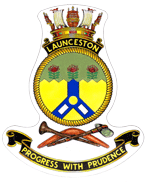HMAS Launceston (ACPB 94)
 HMAS Launceston docked at Riverside in Brisbane, March 2009
| |
| History | |
|---|---|
| Namesake | City of Launceston, Tasmania |
| Commissioned | 22 September 2007 |
| Homeport | HMAS Cairns, Cairns |
| Motto | "Progress With Prudence" |
| Honours and awards | Four inherited battle honours |
| Status | Active as of 2016 |
| Badge |  |
| General characteristics | |
| Class and type | Armidale-class patrol boat |
| Displacement | 300 tons standard load |
| Length | 56.8 m (186 ft) |
| Beam | 9.7 m (32 ft) |
| Draught | 2.7 m (8.9 ft) |
| Propulsion | 2 × MTU 4000 16V 6,225 horsepower (4,642 kW) diesels driving twin propellers |
| Speed | 25 knots (46 km/h; 29 mph) |
| Range | 3,000 nautical miles (5,600 km; 3,500 mi) at 12 knots (22 km/h; 14 mph) |
| Endurance | 21 days standard, 42 days maximum |
| Boats & landing craft carried | 2 × Zodiac 7.2 m (24 ft) RHIBs |
| Complement | 21 standard, 29 maximum |
| Sensors and processing systems | Bridgemaster E surface search/navigation radar |
| Electronic warfare & decoys |
|
| Armament |
|
HMAS Launceston (ACPB 94) is an Armidale-class patrol boat of the Royal Australian Navy (RAN).
Design and construction
The Armidale-class patrol boats are 56.8 metres (186 ft) long, with a beam of 9.7 metres (32 ft), a draught of 2.7 metres (8 ft 10 in), and a standard displacement of 270 tons.[1] The semi-displacement vee hull is fabricated from aluminium alloy, and each vessel is built to a combination of Det Norske Veritas standards for high-speed light craft and RAN requirements.[2] The Armidales can travel at a maximum speed of 25 knots (46 km/h; 29 mph), and are driven by two propeller shafts, each connected to an MTU 16V M70 diesel.[3] The ships have a range of 3,000 nautical miles (5,600 km; 3,500 mi) at 12 knots (22 km/h; 14 mph), allowing them to patrol the waters around the distant territories of Australia, and are designed for standard patrols of 21 days, with a maximum endurance of 42 days.[3][2]
The main armament of the Armidale class is a Rafael Typhoon stabilised 25-millimetre (0.98 in) gun mount fitted with an M242 Bushmaster autocannon.[3] Two 12.7-millimetre (0.50 in) machine guns are also carried.[4] Boarding operations are performed by two 7.2-metre (24 ft), waterjet propelled rigid-hulled inflatable boats (RHIBs).[2] Each RHIB is stored in a dedicated cradle and davit, and is capable of operating independently from the patrol boat as it carries its own communications, navigation, and safety equipment.[2][5]
Each patrol boat has a standard ship's company of 21 personnel, with a maximum of 29.[3][2] The Armidales do not have a permanently assigned ship's company; instead, they are assigned to divisions at a ratio of two vessels to three companies, which rotate through the vessels and allow the Armidales to spend more time at sea, without compromising sailors' rest time or training requirements.[2][6] A 20-berth auxiliary accommodation compartment was included in the design for the transportation of soldiers, illegal fishermen, or unauthorised arrivals; in the latter two cases, the compartment could be secured from the outside.[7] However, a malfunction in the sewerage treatment facilities aboard HMAS Maitland in August 2006 pumped hydrogen sulphide and carbon monoxide into the compartment, non-fatally poisoning four sailors working inside, after which use of the compartment for accommodation was banned across the class.[6][7]
Launceston was constructed by Austal at their shipyard in Henderson, Western Australia.[1] She was commissioned in Launceston, Tasmania[citation needed] on 22 September 2007.[1]
Operational history
She is based in Cairns and performs border protection and fisheries protection patrols.
Launceston was used for pick-up filming during the creation of the second season of Australian drama series Sea Patrol in 2008.[8] The footage was conflated with the main footage of sister ship Broome to create the fictional HMAS Hammersley, the ship the series is set on.[8]
Citations
- ^ a b c Saunders (ed.), IHS Jane's Fighting Ships 2012–2013, p. 33
- ^ a b c d e f Kerr, Plain sailing
- ^ a b c d Wertheim (ed.), The Naval Institute Guide to Combat Fleets of the World, p. 22
- ^ Heron & Powell, in Australian Maritime Issues 2006, p. 132
- ^ Heron & Powell, in Australian Maritime Issues 2006, p. 131
- ^ a b Kerr, Patrol boats shake down fuel faults
- ^ a b McKenna, Gas risk remains for navy boats
- ^ a b Idato, Michael (31 March 2008). "All ship shape". SydneyMorningHerald.com.au, Entertainment (TV and Radio) section. p. 2. Retrieved 10 April 2008.
References
- Books
- Heron, Wesley; Powell, Anthony (2007). "Welcome to the Armidale Class". In Forbes, Andrew; Lovi, Michelle (eds.). Australian Maritime Issues 2006 (PDF). Papers in Australian Maritime Affairs. Sea Power Centre – Australia. pp. 129–134. ISBN 0-642-29644-8. ISSN 1327-5658. Retrieved 12 May 2010.
- Saunders, Stephen, ed. (2012). IHS Jane's Fighting Ships 2012–2013. Jane's Fighting Ships. Coulsdon: IHS Jane's. ISBN 9780710630087. OCLC 793688752.
- Wertheim, Eric, ed. (2007). The Naval Institute Guide to Combat Fleets of the World: Their Ships, Aircraft, and Systems (15th ed.). Annapolis, MD: Naval Institute Press. ISBN 978-1-59114-955-2. OCLC 140283156.
- Journal and news articles
- Kerr, Julian (1 January 2008). "Plain sailing: Australia's Armidales prove fit for task". Jane's Navy International. Jane's Information Group.
- Kerr, Julian (8 December 2007). "Patrol boats shake down fuel faults". The Australian: Defence Special Report. News Corporation. p. 8.
- McKenna, Michael (2 January 2010). "Gas risk remains for navy boats". The Australian. Retrieved 7 January 2010.
- Websites and other media
- "Navy's Twelfth Armidale Class Patrol Boat Commissions" (Press release). Department of Defence. 22 September 2007. Retrieved 24 September 2007.
